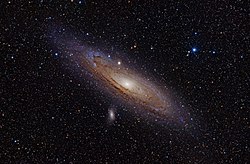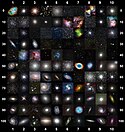Not So Dead After All Messier 110
Messier 110 may not look like much, but it is a fascinating near neighbour of our home galaxy, and an unusual example of its type. It is a member of the Local Group, a gathering of galaxies comprising the Milky Way and a number of the galaxies closest to it. Specifically, Messier 110 is one of the many satellite galaxies encircling the Andromeda Galaxy, the nearest major galaxy to our own, and is classified as a dwarf elliptical galaxy, meaning that it has a smooth and almost featureless structure. Elliptical galaxies lack arms and notable pockets of star formation — both characteristic features of spiral galaxies. Dwarf ellipticals are quite common in groups and clusters of galaxies, and are often satellites of larger galaxies.
Because they lack stellar nurseries and contain mostly old stars, elliptical galaxies are often considered ‘dead’ when compared to their spiral relatives. However, astronomers have spotted signs of a population of young, blue stars at the centre of Messier 110 — hinting that it may not be so dead after all.Relevante Bilder
Relevante Artikel
Messier 110Messier 110 ist eine elliptische Galaxie mit den Abmessungen 19,5' × 11,5' im Sternbild Andromeda. Sie ist ein Begleiter von Messier 31, dem Andromedanebel, und wie dieser 2,7 Millionen Lichtjahre entfernt. Messier 110 wird heutzutage als sphärische Zwerggalaxie klassifiziert. Ihre Masse wird auf 3,6 bis 15 Milliarden Sonnenmassen geschätzt. Sie hat einen Halo mit acht Kugelsternhaufen. .. weiterlesen



